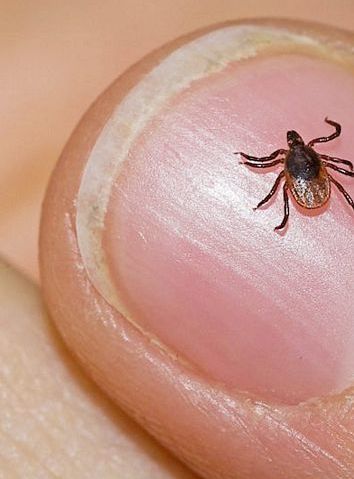Ticks are part of outdoor life, so be sure to check
Most of us have found at least one in our lifetime, whether already burrowed into our skin or waiting for just the right moment to attach for a fresh meal. Ticks are an unwelcome parasite that can be hard to remove and can sometimes carry disease.
According to Gary Graham, Ph.D., OSU state specialist in natural resources, Holmes County residents have not seen an abundance of ticks yet this year. The cold weather has not been a deterrent, as the ticks simply bury themselves into the ground and go into a hibernation stage. The problem that we are seeing is that we are getting more and more deer ticks in the area and the cases of Lyme disease have gone up. Not every deer tick has Lyme, but it has the potential.
The health department here is working really hard at this, said Graham. We had some meetings last year to work on it, but it is hard for the medical community to validate that we have Lyme. People say it is an eastern thing but its not. Its here too. The bad thing is, Lyme disease acts so differently in different people. It can go from flulike symptoms to neurological systems quickly. The range is so wide, you have to take it seriously.
There are a lot of ticks in this area. But some of them we dont see and they are not a problem. They are not a disease vector like the dog tick, blacklegged (deer) tick, and the lone star tick. These are the three important species in Ohio, said Graham.
We have all three of them here, Graham said. The biggest thing I can say is, anybody that works in the woods, hunts, hikes, spends time in the woods or tall grasses, needs to do tick checks when they come in at night. The deer ticks can be found in woody brush and leaf litter. Dog ticks are going to be more in tall grasses. The old theory is that they fall out of the trees on you. In actuality, ticks never get much higher than your knees. They dont crawl up trees and drop down on you. All ticks are blind, so they wouldnt be able to time that drop. They sense their prey by carbon dioxide, so any warm-blooded mammal is a target.
The dog tick can carry Rocky Mountain spotted fever, said Graham. The lone star tick carries its own special diseases, and the blacklegged tick can carry Lyme disease. The big thing is, if you are out in their environment, you need to do a complete body tick check. If they do bite in, if you can get them off within 24 hours, the chances of them having transferred any of these diseases to you is low. They need to bite in, cement their mouth parts in and get established before they start to draw a blood meal. If you can do a check every day when you come in from the woods, the chances of getting them off of you before they do harm is much higher.
Another interesting thing about these ticks is that they can move really fast. Im 6 foot, and that tick can get on the toe of my shoe and be on the top of my head in under 10 minutes, said Graham. Dog ticks like to embed themselves high. If you find them on your dog, typically they are going to be on the back of their necks, the top of their back. Humans are the same thing. The tick is going to find that high spot on your body. Deer ticks dont care. They will embed wherever they find a place to embed. They are not choosy.
To get a tick off, Graham said, it is critical to do it right. You grab it with tweezers, right next to the skin, and gently pull up. You dont want to jerk it off, but gently pull up. After pulling the tick off, disinfect the area and save the tick. Typically a ziplock bag works best, with a lightly moistened paper towel. In case you get sick, they may want to check the tick to see if the tick has a disease.
If it has embedded on you, it is important you get it off. You shouldnt use your fingers, because if you squeeze the tick and the juices break out, you dont want that on your hands.
Dr. McFadden is really up to speed on the tick issue. They are working hard in the medical community here. After you get the tick off, you can take it to them or bring it to me. It needs to be in a double ziplock bag for me. Bring it to me and Ill identify it. Its important not to throw them away or flush them down the toilet.
Preventative measures include putting your socks over your pant legs before going into the woods or fields. Wear light colored clothing to make it easier to find ticks. Use repellents and follow directions carefully. Bathe or shower within two hours of exposure to more easily find ticks.
Dont be afraid of the outdoors. Know the ticks are out there and check yourself and your kids when you come in. If you have pets, especially if you are living near a wooded area, check them. The ticks can ride in with the dog or cat and move to you.
For more information, call Graham at Holmes County Extension at 330-674-3015.

